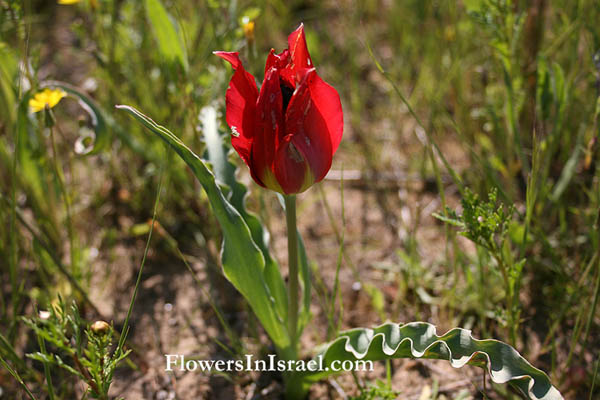Tulipa systola, Tulipa amplyophylla, Desert Tulip,
Hebrew: צבעוני המדבר, Arabic: تيوليب أحمر
|
|
| Scientific name: |
| Tulipa systola Stapf |
| Synonym name: |
| Tulipa amplyophylla (Post) Feinbrun |
| Common name: |
| Desert Tulip |
| Hebrew name: |
| צבעוני המדבר |
| Arabic name: |
| تيوليب أحمر |
| Family: |
| Liliaceae, שושניים |
|
|
| Life form: |
| Geophyte |
| Stems: |
| Flower stem with a single flower, 20 cm high |
| Leaves: |
| 2 leaves, entire |
| Flowers: |
| Red |
| Fruits / pods: |
| Loculicidal capsules |
| Flowering Period: |
| February, March, April |
| Habitat: |
| Shrub-steppes |
| Distribution: |
| Mediterranean Woodlands and Shrublands, Semi-steppe shrublands, Shrub-steppes, Deserts and extreme deserts |
| Chorotype: |
| Irano-Turanian |
| Summer shedding: |
| Ephemeral |

Derivation of the botanical name:
Tulipa, from the Persian word "thuliban" or "dulbend", meaning "a turban". This evolved into the Turkish "dulbend" and "tulbend, Latin "tulipa" and English "tulip".
systola, Greek systole, contraction.
- The standard author abbreviation Stapf is used to indicate Otto Stapf (1857 – 1933), an Austrian born botanist.
- The standard author abbreviation Post is used to indicate George Edward Post (1838 – 1909), an American physician and clergyman.
- The standard author abbreviation Feinbrun is used to indicate Naomi Feinbrun-Dothan (1900 – 1995), an Israeli botanist.
If the rain does not wet the soil to the depth of the root initials until January, Tulipa systola produces only leaves and there are no flowers that year. When rain starts earlier in the season, plants that produce only one large leaf are vegetative throughout the season and no flowers develop. Other plants that develop three leaves may flower and produce seeds. All these factors are dependent on the distribution of rain and the soil water content during the different stages of development of flowers and seeds.
|

